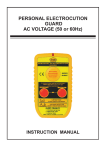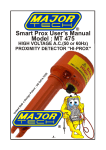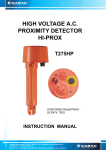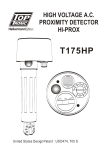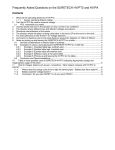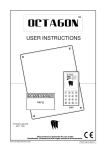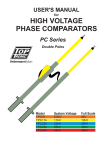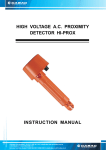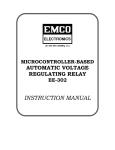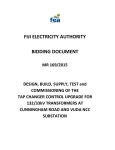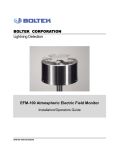Download 270HP Smart-Prox Leaflet
Transcript
Model: 270HP Smart-Prox HIGH VOLTAGE PROXIMITY DETECTOR The NEW Smart-Prox 270HP is a Smart High Voltage Proximity detector. It is • 10 voltage settings: 240Vac, 2kV, Microprocessor Controlled. The design is 3.3kV, 6kV, 11kV, 22kV, 33kV, 66kV, exclusive and has no equivalent to date. 132kV, and 275kV (11 for special). It has ten voltage detection settings from 240Vac to • Ultra High bright LEDs indication. 275kVac as standard and can accommodates up to 11 settings for customs applications. • Loud High Pitch Sound indication. The Smart-Prox 270HP is a “Fail-Safe” Design • Self Test & Diagnostic Circuitry. with an Internal Pickup Sensor coupled to a • Friendly Priority Alert Reporting. Permanent Diagnostic Test Pulsing System, a Rotary Sensitivity Selector, a Powerful Red Flash • Fail Safe Design. Light and a High Pitch Buzzer, all driven • High impact Nylon type casing. independently from each other. • Different Alerting Sound & Light. A very easy to understand “Priority Alert” • Built-In Sunrise (stick) link adaptor. Reporting System (Audio and Visual) let the user • D.S.P. Pass-band Filter (40 to 70Hz). know if an ac, 50 or 60Hz signal has been detected (Buzzer and Red Light, BOTH “ON”) by • Suitable for indoor and outdoor use Smart-Prox, if batteries are Low (morse type • Detect low voltage on any systems pulsating sound, no light) and if, during standby, everything is OK with the Hardware AND • Low Battery Indication. • All OK indication (Hard & Software). Software (Quick Sound followed by Quick Red Flash). With the Smart-Prox 270HP, physical • Two-year warranty contact with electrical conductors is not necessary • Microprocessor Controlled. when testing for live lines. Smart-Prox works by proximity to AC. Its sensor senses the radiated field which surrounds AC live conductors. That Sensed signal is filtered digitally by the microprocessor, using Digital Signal Processing techniques. Only relevant AC signals frequencies are accepted by the microprocessor to alert the user , thus decreasing the false alerts from statics or electrical noise. Detection distance of a 240Vac single wire is ±10cm, with a bunched neutral and earth cable, as in a flexible cable, the distance is reduced to 5cm. Checking or proofing the tester is done automatically by the Diagnostic Test Pulses. The Smart-Prox 270HP has a special circuitry which United States Design Patent : US D474, 705 S Smart-Prox 270HP - Designed for Professionals test itself entirely. The Diagnostic Circuitry test the following: The Sensor plate, the wiring from the main PCB to the sensor, the wiring from the sensor to the Test Pulse circuit, the microprocessor program, the Buzzer, the Red Light and of course, the working of the sensing pulses. Once all these are correct, and only then, Smart-Prox report on it’s status by using a quick Buzz, followed by a quick Red flash, indicating EVERYTHING IS WORKING OK - WAITING FOR AC. As you can see, the indications are also tested and the user can determine that everything is ok. The NEW Smart-Prox 270HP is enclosed into a water tight Nylon, flame retardant material enclosure and uses 3 x 1.5V “C” size batteries. Some of the typical uses are : identify and check live cables; find fault in flexible cables; check earth equipment; service neon lightning; trace live wires; detect residual or induced voltages. For example, faults in damaged flexible cables are found by applying low voltage to each conductor. Earth the remainder and moving the tester along the cable until the change in condition is obtained. (Flexible cables which are used in mining and building industries, are readily repairable when the break in the cable is located.) When testing for high voltage, the rotary switch (attenuator) is used to identify and differentiate various HV live cables. The tester must be used in conjunction with a long and insulating rod when measuring high voltage (kV). Questions / Answers Leds / Buzzer Driven independently I assume that the buzzer and LEDs are controlled separately by the micro? Why is this better? There are 2 transistors driven independently from 2 different pins of the micro. If one circuit should fail, it is unlikely that the other would fail at the same time. So, the user could still use the tester to detect Vac as when Vac is detected, both the buzzer and the Red Light must be ON. If one failed, the user would know that when the Light or the Buzzer is ON, it’s that Vac has been detected. This is the only case where the buzzer or the light stays ON. They are both independent from each other, even inside the micro, the pins are separates. D.S.P. Type Pass Band Filter 40 to 70 Hz Is this to limit the detected voltages to “line” systems only? Yes, the 270HP must only detect 50 or 60Hz basically, this is because the 275HP would also buzz with static electricity, for example when you rub it on your clothes. Of course, It does not matter if it does that when you rub it on your clothes, that was the old accepted method of testing if the product was working in the past. But when the head of the 275HP is close to a dead HV cable which is swigging in the air, that static also trigger the 275HP, not the 270HP. In some cases, the 275HP kept buzzing on dead cables, just because of the static generated by the swing on the cable in the air. The use of a digital filter make the other products look a bit “old” by it’s ability to differentiate between non AC signal and signals which are not between 40 to 70 Hz Does this improve voltage discrimination where there are dual voltages (we have LV cables at 1 level on the pole and then 11kV a few meters higher on the same pole and some times the 11kV signal can confuse someone testing the LV (415V) lines. I would think that it does not, where mixed voltages are present, the same thing should happen. The way to discriminate that is with the sensitivity selector and the distance. PRODUCT COMPARISON TABLE Hi-Prox (275HP) Versus Smart-Prox (270HP) FUNCTION Hi-Prox Smart-Prox (275HP) (270HP) Detects Proximity of AC Voltage Voltage Sensitivity Selector User’s Manual Sunrise Head (Hot Stick Adaptor) - Built-In Nylon Flame Retardant Material 2 Years Warranty 2 High Bright Red Leds 4 High Bright Red Leds NEW High Power / High Pitch Buzzer Leds / Buzzer Driven independently NEW Leds / Buzzer Driven Together Pulsing Signal for Low Battery (no light) NEW Vac Detect = Continuous Buzz and Light Permanent Diagnostic and Test Signal NEW Test Signal Position on Selector Battery Voltage Measurement - On Line - NEW D.S.P. Type Pass Band Filter 40 to 70 Hz NEW Up to 11 Voltages Selection on Request NEW Different Alerting Sounds and Light NEW Water Tight Enclosure Fail Safe Design by Watch Dog Timer NEW Internal Hardware Checked by Test Pulses NEW Maximum Sensitivity if Switch Fails ‘Open’ 3 x 1.5V D Size Cells for Long Life Standby ‘All OK’ Quick Buz then Quick Lit NEW Priority Alert System: Vac, Low Bat, OK NEW Turn OFF if Switch Fails ‘Short Circuit’ NEW Microprocessor Controlled NEW Smart-Prox 270HP - Designed for Professionals Different Alerting Sounds and Light What are the different sounds and lights and what do they do? If the tester is in the off position, then it look dead, everything is off, the light and the buzzer and can't detect anything -It’s OFF-. If the tester is on (any sensitivity) and the batteries are ok and no Vac is detected, it does buzz quickly and then flash quickly too, then send the Test and Diagnostic pulses, analyze them and if the batteries are ok and no Vac is detected, it does buzz quickly and then flash quickly too, then send the Test and Diagnostic pulses ...etc... If batteries are too low, it does pulse the buzzer only (morse code type) then still ,send the Test and Diagnostic pulses, analyze them, etc.... In the case of low batteries, the 270HP does only buzz the buzzer morse code type to conserve battery life. All the other functions are still actives. As the batteries goes down, the sensitivity increase automatically. If Vac 40 to 70Hz is detected, it does buzz and light continuously. The Vac detection Alert has priority on the low battery and on the all ok signals. So even if everything is ok and if the battery is low, if it detects Vac, it will go into voltage detection mode and pass the low battery alert and the everything ok alert. The Low battery has priority on the all ok signals. Even if everything is ok, if a low battery is detected, the 270HP will buzz pulse morse sound type, but still measure Vac, etc... Fail Safe Design by Watch Dog Timer What does this do? If for any reason the software get stopped or if there is a condition which stops the micro, it will reset by itself and restart, just like an ON/OFF switch. The watch dog timer keep everything running smoothly, if the software does not goes where it should, then it will reset the device and start from scratch again. Standby ‘All OK’ Quick Buzz then Quick Lit When I turn the sample ON it just goes straight into the test diagnostic pulse mode. Is it supposed to do a “full Check” first with the LEDs and Buzzer coming ON together for a second or so? The tester start working normally after around one to 2 seconds. it will goes straight in test diagnostic pulse mode after starting. It does a full check all the time, unless Vac is detected. Priority Alert System: Vac, Low Bat, OK What is this doing? same as different alerting sounds and light explanation above. Limitations of use : It is recommended that the 270HP is not used in HV yards of mixed voltages. In the presence of mixed voltages, it could become difficult to determine exactly which source has been detected or which source created the alert. Specifications subject to change without notice. sold By: 7HWUD(QJLQHHULQJ/LPLWHG TEL : FAX : e-mail : VDOHV#WHWUDOWGFRP





